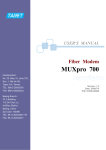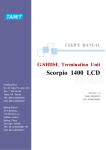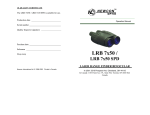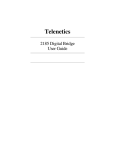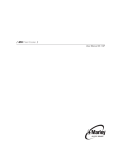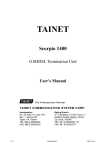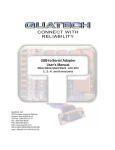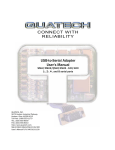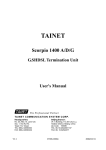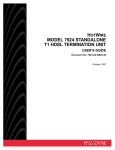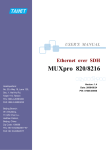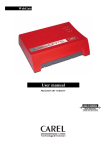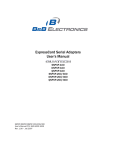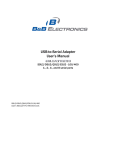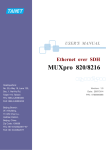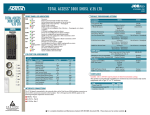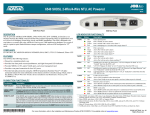Download MUXpro 700 User Manual
Transcript
TAINET MUXpro 700 Fiber Modem User's Manual The Professional Partner TAINET COMMUNICATION SYSTEM CORP. V1.1 Headquarters: Beijing Branch: No. 25, Alley 15, Lane 120, Sec. 1. Nei-Hu Rd, Taipei 114, Taiwan TEL: 886-2-26583000 FAX: 886-2-26583232 3F, A Building, 113 Zhi Chun Lu, HaiDian District, Beijing, China Zip Code: 100086 TEL: 86-10-62522081~87 FAX: 86- 10-62522077 07008-00080 2005/11/10 MUXpro 700 User’s Manual Copyright © 2005 TAINET COMMUNICATION SYSTEM CORP. All right reserved Printed in Taiwan R.O.C. Notice This document is protected by the international copyright law. No part of this publication may be reproduced by any means without the permission of Tainet Communication System Corporation. TAINET is a registered trademark, and Scorpio 1000 as well as MUXpro 700 are trademark of Tainet Communication System Corporation. Other product names mentioned in this manual are used for identification purposes only and may be trademarks or trademarks of their respective companies. The information provided from Tainet Communication System Corporation is believed to be accurate. Any changes and enhancements to the product and to the information thereof will be documented and issued as a new release to this manual. Trademark All products and services mentioned herein are the trademarks, service marks, registered trademarks or registered service marks of their respective owners. -i- MUXpro 700 User’s Manual ABOUT THIS MANUAL This section guides you on how to use the manual effectively. The manual contains information needed to install, configure, and operate TAINET’s MUXpro 700 termination units. The summary of this manual is as follows: Chapter 1: Overview Describes SCORPIO 1000 and how to use MUXpro 700 in several applications. Chapter 2: Specifications Describes the features, specifications and applications of MUXpro 700. Chapter 3: Interfacing Introduces all the interfaces, including front panel and rear panel. Chapter 4: Installation Step-by-step guide to assist user to install and verify the MUXpro 700. Chapter 5: Operation Of Cid Gives a description of the CID (Craft Interface Device). Appendix A: Order Information Describes all the MUXpro 700 series products. Appendix B: Menu Tree Describes the LCD and VT-100 menu tree. Appendix C: Pin Assignment Describes all cables and connectors with pin definition. Appendix D: Trouble Shooting Provides brief trouble shooting list. Appendix E: Trouble Report Trouble Report Form Appendix F: Glossary -ii- MUXpro 700 User’s Manual SYMBOLS USED IN THIS MANUAL 3 types of symbols are used throughout this manual. These symbols are used to advise the users when a special condition arises, such as a safety or operational hazard, or to present extra information to the users. These symbols are explained below: Warning: This symbol and associated text are used when death or injury to the user may result if operating instructions are not followed properly. Caution: This symbol and associated text are used when damages to the equipment or impact to the operation may result if operating instructions are not followed properly. Note: This symbol and associated text are used to provide the users with extra information that may be helpful when following the main instructions in this manual. -iii- MUXpro 700 User’s Manual WARRANTY AND SERVICE If there are any questions, contact your local sales representative, service representative, or distributor directly for any help needed. You might use one of the following methods.. Contact: Via the Internet: visit our World Wide Web site at http://www.tainet.net Via the Sales Representatives: HQ No. 25, Alley 15, Lane 120, Sec. 1. N e i -H u Rd. Taipei, Taiwan, R.O.C. TEL: (886) 2-2658-3000 E-mail: [email protected] FAX: (886) 2-2658-3232 URL: http://www.tainet.net/ . - - s - Beijing Branch 3F, A Building, 113 Zhi Chun Lu, HaiDian District, Beijing, China Zip Code: 100086 TEL: (86) 10-62522081~87 E-mail: [email protected] FAX: (86) 10-62522077 URL: http://www.tainet.com.cn -iv- MUXpro 700 User’s Manual TABLE OF CONTENTS CHAPTER 1. OVERVIEW ...........................................................................................................1 1.1 PRODUCT OVERVIEW ...............................................................................................1 1.2 APPLICATIONS .........................................................................................................1 CHAPTER 2. SPECIFICATION ..................................................................................................5 2.1 MAIN FEATURES.......................................................................................................5 2.2 OPTICAL INTERFACE .................................................................................................5 2.3 NETWORK SIDE INTERFACE .......................................................................................6 2.3.1 T1 Interface ............................................................................................................... 6 2.3.2 E1 Interface ............................................................................................................... 6 2.3.3 V.35 Interface ............................................................................................................ 6 2.3.4 Ethernet Interface...................................................................................................... 6 2.4 USER INTERFACE .....................................................................................................7 2.4.1 2.5 2.6 Connectors ................................................................................................................ 7 TIMING AND SYNCHRONIZATION .................................................................................7 OAM&P .................................................................................................................7 2.6.1 Interface & Self Test .................................................................................................. 7 2.6.2 Maintenance.............................................................................................................. 8 2.6.3 Alarm ......................................................................................................................... 8 2.6.4 Performance.............................................................................................................. 8 2.7 2.8 OTHER TECHNICAL SPECIFICATIONS ..........................................................................8 APPLICATIONS .........................................................................................................9 2.8.1 Cellular Network ........................................................................................................ 9 2.8.2 Campus Network ....................................................................................................... 9 2.8.3 E1 Network .............................................................................................................. 10 CHAPTER 3. INTERFACING ................................................................................................... 11 3.1 FRONT PANEL ........................................................................................................ 11 3.1.1 Status Indicators .......................................................................................................11 3.1.2 Ethernet RJ-45 Pin Assignment................................................................................11 3.2 REAR PANEL ..........................................................................................................12 3.2.1 E1 and T1 RJ-48 Pin Definition for Interface ........................................................... 13 CHAPTER 4. INSTALLATION..................................................................................................15 4.1 UNPACKING ...........................................................................................................15 CHAPTER 5. OPERATION OF CID .........................................................................................17 5.1 OVERVIEW.............................................................................................................17 5.2 CONFIGURATION ....................................................................................................18 5.2.1 Configuration–System ............................................................................................. 19 -v- MUXpro 700 User’s Manual 5.2.2 Configuration–Interface ........................................................................................... 21 5.2.3 Configuration–Modem ............................................................................................. 26 5.2.4 Configuration-Security ............................................................................................. 28 5.3 MONITOR ..............................................................................................................29 5.3.1 Monitor-Alarm .......................................................................................................... 29 5.3.2 Monitor-Modem ....................................................................................................... 32 5.4 SOFTWARE DOWNLOAD ..........................................................................................33 5.5 DIAGNOSIS ............................................................................................................33 APPENDIX A ORDERING INFORMATION .......................................................................35 APPENDIX B MENU TREE....................................................................................................37 APPENDIX C PINS ASSIGNMENT.......................................................................................41 APPENDIX D TROUBLE SHOOTING .................................................................................47 APPENDIX E TROUBLE REPORT.......................................................................................49 APPENDIX F GLOSSARY......................................................................................................51 -vi- MUXpro 700 User’s Manual FIGURES FIGURE 1-1 APPLICATION OF BACK-TO-BACK ................................................................................................ 2 FIGURE 1-3 POSSIBLE INTERFACE CONFIGURATION OF S1000/MUXPRO 700 SYSTEM ................................... 3 FIGURE 2-2 NETWORK APPLICATION OF THE MUXPRO 700 WITH G.703 I/F ................................................. 10 FIGURE 2-3 NETWORK APPLICATION OF THE MUXPRO 700 ......................................................................... 10 FIGURE 3-3 DB-25 FOR E1/T1 AND VARIOUS DTE INTERFACE .................................................................... 13 FIGURE 5-1 STU-C SIDE ACTIVATED LOOPBACK ........................................................................................ 27 FIGURE 5-2 STU-R SIDE ACTIVATED LOOPBACK ........................................................................................ 27 FIGURE C-1 THE CONVERSION CABLE OF DB-25(M) TO V.35(F) ................................................................. 41 FIGURE C-2 DB-25M INTERFACE ................................................................................................................ 41 FIGURE C-3 V.35 INTERFACE ...................................................................................................................... 41 FIGURE C-4 RS-530 INTERFACE ................................................................................................................. 42 FIGURE C-5 DB-37F INTERFACE................................................................................................................. 43 FIGURE C-6 X.21 INTERFACE ...................................................................................................................... 44 FIGURE C-7 DB-9 INTERFACE ..................................................................................................................... 45 FIGURE C-8 RJ-45 INTERFACE ................................................................................................................... 45 -vii- MUXpro 700 User’s Manual TABLES TABLE 2-1 TIMING AND SYNCHRONIZATION ...................................................................................................... 7 TABLE 3-1 INDICATORS ON FRONT PANEL ...................................................................................................... 12 TABLE 3-2 4E1/4T1 INTERFACE PIN ASSIGNMENT .......................................................................................... 13 TABLE 3-3 RJ-48 E1/T1 PIN DEFINITION ........................................................................................................ 13 TABLE 5-1 FIBER ALARMS DESCRIPTION ..................................................................................................... 30 TABLE 5-2 T1/E1 ALARMS DESCRIPTION ....................................................................................................... 30 TABLE A-1 ORDER INFORMATION ................................................................................................................... 35 TABLE B-1 VT-100 MENU TREE .................................................................................................................... 37 TABLE C-1 V.35 CABLE PIN DEFINITION ......................................................................................................... 42 TABLE C-2 RS-530 CONNECTOR PIN DEFINITION ........................................................................................... 42 TABLE C-3 V.36/RS-449 CABLE PIN DEFINITION ........................................................................................... 43 TABLE C-4 X.21 CABLE PIN DEFINITION ........................................................................................................ 44 TABLE C-5 DB-9 CONNECTOR PIN DEFINITION ............................................................................................... 45 TABLE C-6 LAN RJ-45 CONNECTOR PIN DEFINITION ..................................................................................... 45 -viii- Chapter 1 Overview Chapter 1. Overview ABOUT THIS CHAPTER This chapter begins with a general description of TAINET’s MUXpro 700 and how to use the MUXpro 700 in several applications and show the possible interface configurations of MUXpro 700 System. The MUXpro 700 can connect to Scorpio 1000(S1000), S1000 is a high-density universal rack mounted system, which had various interface modules can be used as a concentrator in central office. 1.1 Product Overview The MUXpro 700 fiber modem provides the signal converting /multiplex /de-multiplex functions. The DTE interface of MUXpro 700 can be configured as “4*Ethernet + 4*E1/T1” or “4*Ethernet + 3*E1/T1 + 1*DATA”. The Ethernet interfaces of MUXpro 700 can be used as a hub liked device (it can not act as a LAN switch). The line interface of MUXpro 700 supports 2 Optical Fiber interfaces. One for normal use, and the other for back up (redundancy) purpose. The fiber transmission rate of MUXpro 700 will be 125Mbps, it can convey the traffics of E1/T1, DATA and 10/100baseTx traffic simultaneously over the single pair of fiber to meet the newly IP base application. There is rack type device SCORPIO 1000 (S1000), it provides full coverage of the Last Mile with a variety of technologies, rates, interfaces and media. The system supports standard technologies such as G.SHDSL or optical connected with MUXpro 700. Each card in the S1000 is in a point-to-point configuration opposite to a remote unit with no connection to the adjacent cards. This allows totally independent operation among the ports and cards on the S1000. Three types of technologies will be provided in S1000: 2-wire G.SHDSL modems, 4-wire G.SHDSL modems, and fiber optic MUX. MUXpro 700’s data interfaces allow modem connectivity via a wide range of DTE interfaces. These interfaces include T1, E1, DATA (V.35, V.36 / RS449, X.21, RS-530), or Ethernet. 1.2 Applications The System consists of a central unit at central office, and a remote unit, at customer premises. The services are extended through the technologies of fiber. Various interface -1- Chapter 1 Overview extensions are supported: E1, T1, DATA (V.35, V.36 / RS449, X.21, RS-530), and Ethernet (MUXpro 700 can be acted as a hub through the four LAN ports on the front panel). Figure 1-1 and Figure 1-2 show two typical applications. Figure 1-3 depicts the possible interface configurations. CID/Telnet E1/T1/V35/ Ethernet V.24/Ethernet E1/T1/V35/ Ethernet Optical MUXpro 700 (CPE) MUXpro 700 (CO) Figure 1-1 Application of Back-to-back Telco Central Office Remote Customer Premises Scorpio 1000 ADM G.SHDSL Scorpio 1400 MUXpro 700 Fiber Transport Network E1/T1/V35/ Ethernet MUXpro 700 ADM Fiber MUXpro 700 Fiber V.24 CID V.24 Ethernet Router UNMS DataBase server CID/ Telnet TFTP server Figure 1-2 Application of S1000/MUXpro 700 System -2- E1/T1/V35/ Ethernet 4xE1/T1 3E1/T1+DATA CID Chapter 1 Overview DS1 E1 DS1 E1 V.35 Ethernet Optical STU-C Optical STU-C Optical STU-C Optical STU-C Optical STU-C Optical STU-C STU-R STU-R STU-R STU-R STU-R STU-R DS1 E1 V.35 V.35 V.35 Ethernet Figure 1-3 Possible Interface Configuration of S1000/MUXpro 700 System Note that MUXpro 700 can be configured as STU-C or STU-R, whereas MUXpro 700 should be an STU-R when connected with S1000. -3- Chapter 2 Specification Chapter 2. Specification ABOUT THIS CHAPTER To let the user understand the TAINET MUXpro 700, this chapter begins with its main features. Then, the chapter continues to present the FIBER interface, the network side interface, timing and synchronization, OAM (Operation, Administration and Maintenance) and technical specifications. The last part of this chapter is devoted to the applications of TAINET MUXpro 700 family in different networks, which include cellular network, campus network and E1 network. 2.1 Main Features Listed below are the main features of the MUXpro 700: MUXpro 700 supports DTE interface: T1, E1, DATA (V.35, X.21, RS-530, V.36 / RS449), Ethernet. Support line data rate of 125Mbps. Transmission distance is up to 40Km. Support either 4*E1/T1 + Ethernet or 3*E1/T1+DATA+Ethernet connection for application. Support Timing and Synchronization: Local (internal) timing , Line timing (loop received clock), DTE timing. For test and diagnostic purpose the MUXpro 700 system provides various loopback activated and deactivated function. Management by UNMS or CID. Remote control / monitoring via Telnet and Ethernet. Two optical line interfaces support 1:1 line backup (redundancy) function. Remote software upgrade via TFTP. 2.2 Optical Interface Single Mode. Connector: FC/PC or SC. Laser Wavelength: 1310/1550nm for single mode operation. Fiber Size: 9/125 um. Transmit Power: -5 dBm (min). Receive Power: -34 dBm (min) (For BER 10-10). Dynamic Range: 29 dB (For BER 10-10). -5- Chapter 2 Specification 2.3 Network Side Interface 2.3.1 T1 Interface Bit Rate: 1,544 Kbit / s ± 50 ppm. Frame Format: SF (D4), ESF, field selectable. Line Code: AMI or B8ZS, field selectable. Impedance: Nominal 100 ohms ± 5% resistive. Jitter performance: Meet ITU-T G.824 requirements. Physical Connection Type: DB25 (female) or RJ-45 (100 ohms) in Connector Module. CRC: CRC-6 2.3.2 E1 Interface Comply with G.703 Standard. Bit Rate: 2,048 Kbit / s ± 50 ppm. Frame Format: meet ITU-T G.704 standard. Line Code: High Density Bipolar of Order 3 (HDB3). Impedance: Nominal 120 ohms ± 5% or 75 ohm. Jitter performance: Meet ITU-T G.823 requirements. CRC: CRC-4. Physical Connection Type: DB25 (female) or RJ-45 (120 ohms) in Connector Module. 2.3.3 V.35 Interface Software configurable for V.35 or RS530 or RS-449/V.36 or X.21. Data inversion (Normal Data or Inverse Data mode selected). Date rate: n x 64K bps (n = 1 to 32). Connector: DB-25 with adaptive cable. Clocking mode: DCE slave or DCE external. Clock inversion. Control lead: X.21: C/I. V.35: DTR/RTS/DSR/DCD/CTS/TM. V.36: DTR/RTS/DSR/DCD/CTS. 2.3.4 Ethernet Interface Meet IEEE 802.3 Relative requirements. Connector: RJ-45. 10/100M Auto-Negotiation. -6- Chapter 2 Specification 2.4 User Interface 2.4.1 Connectors Optical port: FC/PC or SC. Ethernet port: RJ-45. E1/T1 port: DB25 (female). DATA port: DB25 (female) 2.5 Timing and Synchronization Table 2-1 shows three modes to be field selectable. Table 2-1 Timing and Synchronization Mode STU-C Symbol STU-R Symbol Example Number Clock Reference Clock Reference Application 1 2 Local oscillator Received symbol (internal timing) clock Transmit data clock Received symbol (DTE timing) clock "Classic" HDSLP synchronous transport Synchronous in both directions. Transmit data clock Received symbol downstream transport (DTE timing) and bit-stuffed clock upstream is possible. 2.6 lesiochronous Main application is Synchronous 3 Mode Hybrid: downstream Synchronous upstream: Plesiochronous OAM&P OAM&P (Operation, Administration, Maintenance and Performance) of the MUXpro 700 is listed below: 2.6.1 Interface & Self Test Transparent UART over 100Base-Fx Ethernet Link for in-band management. LEDs for local monitor and simple trouble-shooting. CPU self test ROM, RAM, interface chipset read/write Fiber interface loop back test E1/T1 interface loop back test DATA interface loop back test -7- Chapter 2 Specification Power monitoring 2.6.2 Maintenance Power On Self Test. Watch Dog Timer. Commanded by CPU. 2.6.3 Alarm Fiber interface LOS. T1/E1 interface LOS. T1/E1 interface AIS. T1/E1 interface LOF. T1/E1 interface RAI. 2.6.4 Performance T1/E1 interface ES. T1/E1 interface SES. T1/E1 interface UAS. 2.7 Other Technical Specifications Table 2-2 gives the other specifications of the MUXpro 700. Table 2-2 Other Specifications of the MUXpro 700 Size Dimension 212mm(W) x 286mm(D) x 42mm (H) Safety Vibration Meet FCC part 68 requirements Safety Meet EN60950, FCC part 68 requirements EMI/EMC Meet CE & FCC part 15 class B requirements Power Requirement Input AC input or DC input voltage: 110V~220VAC or -48VDC Power Consumption 10 W (TBD) Environments Temperature Operation: 0 ~ 45 ºC Storage and Transportation: -20 ~ 70 ºC Operation: 5 ~ 90 % RH (Relative Humidity) Humidity Storage and Transportation: 5 ~ 95 % RH -8- Chapter 2 Specification 2.8 Applications The application of TAINET’s MUXpro 700 is very similar with Scorpio 1400 systems, which include cellular network, campus network and E1/T1 network but the line media. The optical media can support longer transmitted distance and wider bandwidth prevented it from interfering. The transmission distance of single mode optical fiber can be reach to 40Km in according to the standard. 2.8.1 Cellular Network The cellular network user will need to lease larger numbers of E1 circuits in order to connect remote cell sites to mobile telephone switching offices (MTSOs). TAINET MUXpro 700 provides an alternative to standard repeater E1 service. Figure 2-1 shows a cellular network application. Figure 2-1 Point to point Interconnection is instead of E1 2.8.2 Campus Network The MUXpro 700 is well suited to the campus applications. Figure 2-2 and Figure 2-3 show two general campus applications where remote PBX or routers are interconnected across a campus using two MUXpro 700. One unit is configured as a central office site (CO) unit and the other is the customer premise equipment (CPE) unit. -9- Chapter 2 Specification Figure 2-2 Network Application of the MUXpro 700 with G.703 I/F Figure 2-3 Network Application of the MUXpro 700 Each MUXpro 700 is configured at the factory to operate on the CO side of an E1 connection. However, you can easily modify settings intended for the CO into settings for CPE. 2.8.3 E1 Network The MUXpro 700 can be deployed to replace traditional E1 network, without the repeater in the E1 network and effectively the utilization of the existing twisted copper pair. -10- Chapter 3 Interfacing Chapter 3. Interfacing ABOUT THIS CHAPTER In this chapter, we will focus our attention on the interfaces of the MUXpro 700. First, the front panel of the MUXpro 700 will be discussed. After that, we will examine in more detail the rear panel of the MUXpro 700. 3.1 Front Panel The front panel of MUXpro 700, as illustrated in Figure 3-1, contains four main sections, i.e. the LAN RJ45 connector, optical interfaces, LED indicators and management RJ45 interface. From the status indicators of front panel, users can obtain useful information to monitor the status of the MUXpro 700. 10/100 ACT 10/100 1 ACT MUXpro 700 3 Management Optical 1 Tx1 2 Rx1 Optical 2 Tx2 Rx2 Optical 1 2 DATA E1/T1 1 2 10/100 3 ACT PWR 4 4 LAN FRONT PANNEL Figure 3-1 Front Panel of the MUXpro 700 3.1.1 Status Indicators The status indicators of the MUXpro 700 are depicted in Table 3-1. There are eight LEDs, which are Optical 1, Optical 2, DATA, E1/T1 1, E1/T1 2, E1/T1 3, E1/T1 4 and power. These LEDs display the system status. 3.1.2 Ethernet RJ-45 Pin Assignment -11- Chapter 3 Interfacing Pin Description 1 TX+ 2 TX- 3 RX+ 4 NC 5 NC 6 RX- 7 NC 8 NC Table 3-1 Indicators on Front Panel LED Description Color Off Flashing 0,5 sec Always On PWR Power Green No Power N/A Power OK DATA DATA CPE Failure N/A OK Optical 1, 2 Loop Handshaking/ Connecting Training Idle E1/T1 Red Green Failure Green E1/T1 CPE 1,2,3,4 3.2 Green N/A Red N/A Traffic OK Failure Rear Panel The rear panel of the MUXpro 700. Users may connect the MUXpro 700 to other devices or equipments via these interfaces. 0V -48V I O CRAFT E1/T1 DTE REAL PANNEL Figure 3-2 Rear Panel of the MUXpro 700 The following connectors/devices appear on the rear panel of the MUXpro 700. -12- Chapter 3 Interfacing 1 Power On / Off: The MUXpro 700’s power switch 2 Power Receptacle: Power plug for a AC power cable 3 DC power connector: Power connector for DC power 4 Ground Terminal: Ground output terminal, connect to earth. 5 Craft Interface: 9 pin female serial D-sub connector 6 E1/T1 Interface: E1/T1 interface. 7 DTE Interface: Data terminal equipment port The MUXpro 700 supports various DTE (Data Terminal Equipment) interfaces depending on user requirements. Connector type is a 25 pins female connector for E1/T1, V.35, X.21, RS-530, and V.36 / RS449. Tainet will provide the cable converter for various interfaces. Figure 3-3 DB-25 for E1/T1 and various DTE Interface The E1 / T1 interface uses a D-sub25 connector. Pin descriptions are shown in the following table: Pin number 1 2 3 4 5 6 7 8 9 10 11 12 13 Description PortD transmit − PortD receiver + PortC receiver + PortC transmit − PortB transmit − PortB receiver + PortA receiver + PortA transmit − Table 3-2 3.2.1 Pin number 14 15 16 17 18 19 20 21 22 23 24 25 Description PortD transmit + PortD receiver − PortC receiver − PortC transmit + PortB transmit + PortB receiver − PortA receiver − PortA transmit + 4E1/4T1 interface pin assignment E1 and T1 RJ-48 Pin Definition for Interface Pin number 1 2 3 4 Description Receiver Receiver + Transmit Table 3-3 Pin number Description 5 Transmit + 6 7 8 RJ-48 E1/T1 pin definition -13- Chapter 4 Installation Chapter 4. Installation ABOUT THIS CHAPTER In this chapter, we will present the installation guide for the MUXpro 700. It begins with a checklist for unpacking the shipping package. 4.1 Unpacking The MUXpro 700’s shipping package includes the following items: 1 MUXpro 700 standalone unit 1 User’s manual 1 Power cable 1 DB-25 to 4E1 cable converter Optional items(users specify the type of DATA port) DB25 to ITU-T V.35 / RS530 / X.21 DATA interface V.35 cable X.21 cable RS-530 cable V.36 cable -15- Chapter 5 Operation of CID Chapter 5. Operation of CID ABOUT THIS CHAPTER In this chapter, you will be introduced to the CID (Craft Interface Device) VT-100 operation of MUXpro 700. The chapter starts with an overview of MUXpro 700’s CID. In addition, each main menu item of the MUXpro 700’s CID, such as Configuration, Monitor, Software Download and Diagnosis, will be discussed. 5.1 Overview The craft port for configuration is set to Speed: 115200, Data bit: 8, Parity: n, Stop bit: 1, Flow control: n. When startup the device, the following messages will appear before the screen displays the Application software code. RAM test OK!!SelfTest1 OK! SelfTest2 OK! SelfTest3 OK! Select 'a' in 1 second-->into Diagnostic mode, or to AP: dwHeaderCheckSum=0xe9369793 11:59:31 code checksum OK = 0x5766979 At startup of the AP, press Enter, the CID will prompt user to enter the password for access into the system. The default user name and password is tainet. !!! Welcome to Access TAINET MUXpro 700 !!! Please Enter User Name : tainet Password : ****** The CID offers user-friendly menu-driven user interface. The following figure depicts the structure of the interface. The top tier command options include Configuration, Monitor (status), Software Download and Diagnosis (Test). -17- Chapter 5 Operation of CID System TAINET MUXpro 700 Version 1.00 Tier 2 ============================================================================= Tier 3 [IP] Trap IP DateTime Default Reset Product Name Software Version IP Configuration IP Configuration Tier 4 or description IP Address [192.168.1.1 ] NetMask [255.255.255.0 ] Default Gateway [191.168.1.254 ] input operational hint Press: '0' - '9', '.', SPACE, BS, DEL TAB,ENTER: next field '<':left '>':right ESC: abort Product Name: TAINET MUXpro 700. Software Version: the software version number. Tier 2: The second tier of the current screen. Tier 3: The next tier of the current screen. Tier 4 or description: The fourth tier of the current screen and / or its description. Input: the values to be set by the user. Operational hint: a hint for the user during operation. 5.2 Configuration After the password checks out, the CID will bring up the top page or the configuration main menu. There are four items on this page, System, Interface, Modem, and Security. MAIN TAINET MUXpro 700 Version 1.03 ========================================================================= [Configuration] System Monitor Interface Software Download Modem ENTER:select TAB:next '<':left Diagnosis Security '>':right ESC:previous menu -18- Chapter 5 Operation of CID 5.2.1 Configuration–System Configuration TAINET MUXpro 700 Version 1.03 ======================================================================== [System] Interface Modem CO/CPE Mode IP Security Trap IP DateTime ENTER:select TAB:next '<':left Default '>':right ESC:previous menu Before you can remote control / monitoring the device. Setting IP address is required for managing the system via the Management Ethernet port in the Front Panel. This is a must for Telnet and TFTP management. Configuration-System-CO/CPE Mode System TAINET MUXpro 700 Version 1.03 ======================================================================= [CO/CPE Mode] IP Trap Ip DateTime Default Set CO/CPE Mode Configure Muxpro 700 CO/CPE Mode Mode [CO] Press: SPACE to select TAB,ENTER:next field '<':left '>':right ESC:abort The CO device generates the source clock. In opposite device, should be set to CPE mode to follow the CO clock. Configuration-System-IP System TAINET MUXpro 700 Version 1.03 ======================================================================== CO/CPE Mode [IP] Trap Ip DateTime Default IP Configuration IP Configuration IP Address [192.168.1.1 ] NetMask [255.255.255.0] Default Gateway [191.168.1.254] Press: '0' - '9', '.', SPACE, BS, DEL TAB,ENTER:next field '<':left '>':right ESC:abort Above step sets the local device’s IP address. The IP address has to be in the same sub-network with your remote computer IP address. -19- Chapter 5 Operation of CID Configuration-System-Trap IP System TAINET MUXpro 700 Version 1.03 ==================================================================== CO/CPE Mode IP [Trap Ip] DateTime Default Trap IP Configuration TrapIP Configuration Trap IP0 Address [210.65.231.120 Trap IP0 Status [Inactive] Trap IP1 Address [0.0.0.0 Trap IP1 Status [Inactive] Trap IP2 Address [0.0.0.0 Trap IP2 Status [Inactive] Trap IP3 Address [0.0.0.0 Trap IP3 Status [Inactive] Trap IP4 Address [0.0.0.0 Trap IP4 Status [Inactive] ] ] ] ] ] Press: '0' - '9', '.', SPACE, BS, DEL TAB,ENTER:next field '<':left '>':right ESC:abort MUXPro 700 supports four separate points for Network Management System. The TrapIP is the IP address of remote system. Configuration-System-Date Time System TAINET MUXpro 700 Version 1.03 ============================================================================== CO/CPE Mode IP Trap Ip [DateTime] Default Date and Time Setup Date & Time Setup Year [2004 ] Month [1 ] Day [12 ] Hour [16 ] Minute [27 ] Second [18 ] Press: '0' - '9', SPACE, BS, DEL TAB,ENTER:next field '<':left '>':right ESC:abort -20- Chapter 5 Operation of CID Date-Time: The system provides RTC (Real Time Clock) and supports BCD coded century, year, month, date, day, hours, minutes, and seconds with automatic leap year compensation valid up to the year 2100.Set the Date / Time to correctly time-stamping the alarm or PM data report. The date/time will be stored in non-volatile memory, so data will not be lost even when powering off the system (MPU). Configuration-System-Default Default: Reset the configuration data of the device to default values. 5.2.2 Configuration–Interface Configuration TAINET MUXpro 700 Version 1.03 ============================================================================== System [Interface] FIBER T1 E1 Modem Security DATA ENTER:select TAB:next '<':left '>':right ESC:previous menu There are four interface types, which are FIBER, E1, T1 and DATA, available for the MUXpro 700. In addition, the DATA interface also includes V.35, X.21, V36 / RS499, and RS530. Configuration–Interface–FIBER Interface [FIBER] Near End TAINET MUXpro 700 T1 E1 Version 1.03 DATA Far End ENTER:select TAB:next ‘<’:left ‘>’:right ESC:previous menu There are two sub-items for FIBER parameter, which are Near End and Far End. Near End is the device you are controlling and the corresponding device is Far End. Users can set the parameters of Near End and/or Far End device. -21- Chapter 5 Operation of CID Configuration–Interface–FIBER-Near End FIBER [Near End] TAINET MUXpro 700 Version 1.03 Far End Configure Fiber Near End Parameter OE OPTION [Hardware Auto selection] OE LOOP [OE1] DATA PORT LOCATION EMPTY Press: SPACE to select TAB,ENTER:next field '<':left '>':right ESC:abort OE OPTION: The configurable values are Hardware Auto selection or Software configuration. The near end site will connect itself with far end site automatically when selected Hardware Auto selection. Or, the connection is established by user defined (OE1 or OE2) when the Software configuration was selected. OE LOOP: The value of this optical loop selection is OE1 or OE2. OE1 is the master line interface. OE2 is the backup line for OE1. DATA PORT LOCATION: EMPTY EMPTY, PORT1, PORT2, PORT3, PORT4 Configuration–Interface–FIBER-Far End FIBER TAINET MUXpro 700 Version 1.03 ============================================================================== Near End [Far End] Configure Far End Parameter OE OPTION [Hardware Auto selection] OE LOOP [OE1] DATA PORT LOCATION [PORT1] Press: '0' - '9', SPACE, BS, DEL TAB,ENTER:next field '<':left '>':right ESC:abort OE OPTION: The configurable values are Hardware Auto selection or Software configuration. OE LOOP: The value of this optical loop selection is OE1 or OE2. OE1 is the master line interface. OE2 is the backup line for OE1. DATA PORT LOCATION: PORT1, PORT2, PORT3, PORT4, EMPTY A TCA (Threshold Crossing Alert) will be reported if the SNR (Signal to Noise Ratio) margin is lower, or if the Attenuation is higher than the set value. The TCA will be -22- Chapter 5 Operation of CID time-stamped and logged into local memory and in UNMS database. Users can configure the values of Far End and/or Near End. Configuration–Interface–T1 T1 TAINET MUXpro 700 Version 1.03 ============================================================================== [Parameters] Near End Far End ENTER:select TAB:next '<':left '>':right ESC:previous menu MUXpro 700 supports one T1 interface to extend the transmission service. Near End is the device you are controlling and the corresponding device is Far End. Configuration-Interface-T1-Near End Parameters TAINET MUXpro 700 Version 1.03 ============================================================================== [Near End] Far End Configure T1 Near End Parameters Configure T1 Parameters PortNO PORT1 Frame Mode Unframed LineCoding [AMI ] Idle Pattern [0xff] Cable Length [533~655] Press: SPACE to select TAB,ENTER:next field '<':left '>':right ESC:abort There are four ports on the MUXpro 700 (no data interface selected), in the beginning, users must specify the associated port from port1 to port4. Frame Mode: Possible values are Unframed. LineCoding: AMI or B8ZS Idle Pattern: Sending pattern on the unused time slots. The possible values are 0x7f and 0xff. Cable Length: Possible values are 0-133, 133-266, 266-399, 399-533, 533-655.The T1 circuit provides the function of cable length (from 0 to 200 meters) compensation. -23- Chapter 5 Operation of CID Configuration–Interface–E1 Configuration-Interface-E1-Parameter E1 TAINET MUXpro 700 Version 1.03 ============================================================================== [Parameters] Near End Far End ENTER:select TAB:next '<':left '>':right ESC:previous menu Configuration-Interface-E1-Parameter-Near End Parameters TAINET MUXpro 700 Version 1.03 ============================================================================== [Near End] Far End Near End of E1 Configure E1 Parameters PORTNO PORT1 Frame Mode Unframed Impedance Balance Idle Pattern [0xff] Press: SPACE to select TAB,ENTER:next field '<':left '>':right ESC:abort Frame Mode: Possible values are Unframed. Impedance: Nominal 120 ohms resistive symmetrical (Balance) pair or 75 ohm asymmetrical (Unbalance) pair Idle Pattern: Bit sending pattern in the unused time slots. The possible values are 0x7f and 0xff. Configuration–Interface–DATA Configuration-Interface-DATA-Parameters DATA TAINET MUXpro 700 Version 1.03 ============================================================================== [Parameters] Near End Far End ENTER:select TAB:next '<':left '>':right ESC:previous menu -24- Chapter 5 Operation of CID Configuration-Interface-DATA-Parameters-Near End Parameters TAINET MUXpro 700 Version 1.03 ============================================================================== [Near End] Far End Near End of DATA Configure DATA Parameters PORTNO PORT1 DTEType [V35 Tx data inversion [normal ] Rx sample edge [Rising ] Rx data inversion [normal ] E1 Header CRC [disable] exc-pin detect [Enable ] Timing Source [DTE] ] Press: SPACE to select TAB,ENTER:next field '<':left '>':right ESC:abort DTEType : V35, V36 / RS449, X21, or RS530 Tx/Rx data inversion: normal or inverse. The V.35 interface of STU-R provides data inversion capability used to protect against the occurrence of low pulse density. Rx sample edge: Rising or Falling. E1 Header CRC: disable or enable. Exc-pin detect: enable or disable the external clock pin detection of V.35 interface. Timing Source: Internal, Dte, External or Line. -25- Chapter 5 Operation of CID 5.2.3 Configuration–Modem Configuration-Modem-Parameter Modem TAINET MUXpro 700 Version 1.03 ============================================================================== [Parameters] Test Configure Modem Parameters Set Required Modem Type Actual Card Type of Modem FIBER-E1T1-4P Required Modem Type of Near End [FIBER-E1-4P ] Required Modem Type of Far End [FIBER-E1-4P Near End Modem Data Rate: (1~32) *64kbps [32 ] Far End Modem Data Rate: (1~32) *64kbps [32 ] ENTER:select TAB:next '<':left ] '>':right ESC:previous menu Required Modem Type: To select the DTE interface type for near-end and far-end. The possible values are listed below: FIBER-E1-4P (Near End * Far End) FIBER-T1-4P (Near End * Far End) FIBER-DATA-E1 (Far End only) FIBER-DATA-T1 (Far End only) Modem Data Rate: To select the data rate for near-end or far-end. E1 interface the value is from 1 to 32. T1 interface the value is from 1 to 25. Configuration-Modem-Test For test and diagnostic purpose the MUXpro 700 provides various Loopback paths, which are depicted in Figure 5-1 and Figure 5-2. They are Near End (Local Payload) Loopback, Local Loopback, Remote Loopback and Remote Payload Loopback. -26- Chapter 5 Operation of CID STU-C (a) STU-R (c) (b) (d) OPTICAL DS1 or E1 DS1 or E1 STU-C (a) STU-R (c) (b) (d) OPTICAL V.35 DS1 or E1 STU-C (a) STU-R (c) (b) (d) OPTICAL V.35 V.35 STU-C (a) STU-R (c) (b) (d) OPTICAL Ethernet Ethernet Figure 5-1 STU-C Side Activated Loopback STU-C (d) STU-R (c) (b) (a) OPTICAL DS1 or E1 DS1 or E1 STU-C (d) STU-R (c) (b) (a) OPTICAL V.35 DS1 or E1 STU-C (d) STU-R (c) (b) (a) OPTICAL V.35 V.35 STU-C (d) STU-R (c) (b) (a) OPTICAL Ethernet Ethernet Figure 5-2 STU-R Side Activated Loopback -27- Chapter 5 Operation of CID Test TAINET MUXpro 700 Version 1.03 ============================================================================== [Loopback] Loopback test PortNO PORT1 Loopback Test [Local PayLoad Loopback ] Press: SPACE to select TAB,ENTER:next field '<':left '>':right ESC:abort Loopback Test: Possible values are Normal Local Loopback Remote Loopback Local PayLoad Loopback Remote PayLoad Loopback Be Remote Loopback (FarEnd command, Read Only!) Be Remote PayLoad Loopback (FarEnd command, Read Only 5.2.4 Configuration-Security Configuration TAINET MUXpro 700 Version 1.03 ============================================================================== System Interface Modem [Security] Security Configuration Login Username [tainet ] Login Password [tainet ] Press: ASCII, SPACE, BS, DEL TAB,ENTER:next field '<':left '>':right ESC:abort For security, users can define the password for console or telnet login. -28- Chapter 5 Operation of CID 5.3 Monitor Monitor TAINET MUXpro 700 Version 1.03 ============================================================================== [Alarm] Alarm Modem Alarm Log Clear alarm Log SPACE:refresh page '<':page up '>':page down ESC:abort 5.3.1 Monitor-Alarm Alarm TAINET MUXpro 700 Version 1.03 ============================================================================== [Alarm] Alarm Log Clear Alarm Log View Real Time Alarm View Real Time Alarm Select by [All ] SPACE:refresh page '<':page up '>':page down ESC:abort Select by: Possible values are All, Port1, Port2, Port3, Port4, FIBER OE1 and FIBER OE2 to list the alarm log. Alarm TAINET MUXpro 700 Version 1.03 ============================================================================== [Alarm] Alarm Log Clear Alarm Log View Real Time Alarm TYPE Class 1 DSX1(4)_UAS_EXCD_QTR_TRHD WARNING 2 DSX1(4)_UAS_EXCD_DAY_TRHD WARNING 3 DSX1(4)_LOS MAJOR SPACE:refresh page '<':page up '>':page down ESC:abort Alarm severity class: Major, Minor, Warning or Clear. The “(4)” means port number 4. All TCA (Threshold Crossing Alert) are classified as WARNING. Table 5-1 and Table 5-2 show all FIBER alarms and T1/E1 alarms, respectively. -29- Chapter 5 Operation of CID Table 5-1 Alarm Type FIBER Alarms Description Severity Class FIBER_LOSW MAJOR Description Failure of LOSW FIBER_LOSWS_QTR_TRHD WARNING 15-minute LOSW TCA FIBER_LOSWS_DAY_TRHD WARNING 1-day LOSW TCA FIBER_ES_QTR_TRHD WARNING 15-minute ES TCA FIBER_ES_DAY_TRHD WARNING 1-day ES TCA FIBER_SES_QTR_TRHD WARNING 15-minute SES TCA FIBER_SES_DAY_TRHD WARNING 1-day SES TCA FIBER_UAS_QTR_TRHD WARNING 15-minute UAS TCA FIBER_UAS_DAY_TRHD WARNING 1-day UAS TCA FIBER_LOSWS_FE_QTR_TRHD WARNING 15-minute FE LOSW TCA FIBER_LOSWS_FE_DAY_TRHD WARNING 1-day FE LOSW TCA FIBER_ES_FE_QTR_TRHD WARNING 15-minute FE ES TCA FIBER_ES_FE_DAY_TRHD WARNING 1-day FE ES TCA FIBER_SES_FE_QTR_TRHD WARNING 15-minute FE SES TCA FIBER_SES_FE_DAY_TRHD WARNING 1-day FE SES TCA FIBER_UAS_FE_QTR_TRHD WARNING 15-minute FE UAS TCA FIBER_UAS_FE_DAY_TRHD WARNING 1-day FE UAS TCA FIBER_ATN_TRHD WARNING Attenuation TCA FIBER_FE_ATN_TRHD WARNING FE Attenuation TCA FIBER_SNM_TRHD WARNING SNR Margin TCA FIBER_FE_SNM_TRHD WARNING FE SNR Margin TCA Table 5-2 Alarm Type T1/E1 Alarms Description Severity Class Description DSX1_LOS MAJOR Failure of LOS DSX1_LOF MAJOR Failure of LOF DSX1_AIS MAJOR Failure of AIS DSX1_RAI MINOR Failure of RAI DSX1_LOS_FE MAJOR Failure of FE LOS DSX1_LOF_FE MAJOR Failure of FE LOF DSX1_AIS_FE MAJOR Failure of FE AIS DSX1_RAI_FE MINOR Failure of FE RAI DSX1_ES_QTR_TRHD WARNING 15-minute ES TCA DSX1_ES_DAY_TRHD WARNING 1-day ES TCA DSX1_SES_QTR_TRHD WARNING 15-minute SES TCA -30- Chapter 5 Operation of CID DSX1_SES_DAY_TRHD WARNING 1-day SES TCA DSX1_UAS_QTR_TRHD WARNING 15-minute UAS TCA DSX1_UAS_DAY_TRHD WARNING 1-day UAS TCA DSX1_ES_FE_QTR_TRHD WARNING 15-minute FE ES TCA DSX1_ES_FE_DAY_TRHD WARNING 1-day FE ES TCA DSX1_SES_FE_QTR_TRHD WARNING 15-minute FE SES TCA DSX1_SES_FE_DAY_TRHD WARNING 1-day FE SES TCA DSX1_UAS_FE_QTR_TRHD WARNING 15-minute FE UAS TCA DSX1_UAS_FE_DAY_TRHD WARNING 1-day FE UAS TCA Alarm TAINET MUXpro 700 Version 1.03 ============================================================================== Alarm [Alarm Log] Clear Alarm Log View Alarm Log TYPE Class Status Date Time 1 DSX1(4)_UAS_QTR_TRHD WARNING RAISED 01/12/2003 16:46:00 2 FIBER(1)_UAS_QTR_TRHD WARNING RAISED 01/12/2003 16:46:00 3 FIBER(2)_LOSWS_QTR_TRHD WARNING RAISED 01/12/2003 16:46:00 4 DSX1(3)_UAS_QTR_TRHD WARNING CLR 01/12/2003 16:45:00 5 FIBER(1)_UAS_QTR_TRHD WARNING CLR 01/12/2003 16:45:00 6 FIBER(2)_LOSWS_QTR_TRHD WARNING CLR 01/12/2003 16:45:00 7 DSX1(2)_UAS_QTR_TRHD WARNING RAISED 01/12/2003 16:31:00 8 FIBER(2)_UAS_QTR_TRHD WARNING RAISED 01/12/2003 16:31:00 9 FIBER(1)_LOSWS_QTR_TRHD WARNING RAISED 01/12/2003 16:31:00 10 DSX1(2)_UAS_QTR_TRHD WARNING CLR 01/12/2003 16:30:00 11 FIBER(2)_UAS_QTR_TRHD WARNING CLR 01/12/2003 16:30:00 12 FIBER(1)_LOSWS_QTR_TRHD WARNING CLR 01/12/2003 16:30:00 SPACE:refresh page '<':page up '>':page down ESC:abort Up to 200 alarm records can be stored without the use UNMS. Many more can be logged in Database if UNMS is used. -31- Chapter 5 Operation of CID Alarm TAINET MUXpro 700 Version 1.03 ============================================================================== Alarm Alarm Log [Clear Alarm Log] Clear System Alarm Log +-Clear ?------+ |<YES> NO | +----------------+ TAB:next '>':forward '<':backward ENTER:select ESC:abort Users can view or clear the alarm logs if it is necessary. 5.3.2 Monitor-Modem Modem TAINET MUXpro 700 Version 1.03 =============================================================================== [Version Info] Modem Status Led Status Version Information Main Hardware Version 1.00 Software Version 1.03 FPGA Version 0.00 TAB,ENTER:next field '<':left '>':right ESC:abort Modem TAINET MUXpro 700 Version 1.03 ============================================================================== Version Info [Modem Status] Led Status Modem Status PortNO PORT1 Near End Modem Type FIBER-E1-4P Far End Modem Type FIBER-E1-4P Near End Port Rate 2048 Trunk Timing Source Through Mode TAB,ENTER:next field '<':left Modem '>':right ESC:abort TAINET MUXpro 700 -32- Version 1.03 Chapter 5 Operation of CID ============================================================================== Version Info Modem Status [Led Status] Led Status PortNO PORT1 LED Status: OE1 Inactive LED Status: OE2 Inactive LED Status: E1T1 RED LED Status: DATA Inactive …………….. TAB,ENTER:next field '<':left 5.4 '>':right ESC:abort Software Download MAIN TAINET MUXpro 700 Version 1.03 ============================================================================== Configuration Monitor [Software Download] Diagnosis Download Software From TFTP Server Server IP Address [192.168.1.1 ] File Name [mp700v103.img ] Start Downloading [Yes ] Press: '0' - '9', '.', SPACE, BS, DEL TAB,ENTER:next field '<':left '>':right ESC:abort TFTP software upgrade is supported. Users can specify the IP address of TFTP server and file name for downloading through the Management port in the front panel by cross cable. 5.5 Diagnosis MAIN TAINET MUXpro 700 Version 1.03 ================================================================================ Configuration Monitor Software Download [Diagnosis] Trouble Shooting Menu ENTER:select TAB:next '<':left '>':right ESC:previous menu -33- Chapter 5 Operation of CID Diagnosis TAINET MUXpro 700 Version 1.03 ============================================================================== [Trouble Shooting Menu] View System Debug Messages debug: 11d0000**************************************************ESS ... Type 'Q' to Quit The “Diagnosis” is used by expert engineer for the purpose of troubleshooting. Users may ignore it if users are not so familiar with it. -34- Appendix A Ordering Information Appendix A Ordering Information Table A-1 is the order information for your reference. Table A-1 Part Number Order Information Ordering No. Description Standalone fiber optic modem w/ 3 E1 balanced interface, one DATA MUXpro 700AC3E1/DATA/B/? 000-101-0063 (V.35/V.36/RS-530/X.21), and 4-ports 10/100M Ethernet interface, 1310nm for up to 40km distance, FC/PC connector, with built-in 100~240VAC auto range power Standalone fiber optic modem w/ 4 E1 balanced interface and MUXpro 700AC-4E1/B/? 000-101-0064 4-ports 10/100M Ethernet interface, 1310nm for up to 40km distance, FC/PC connector, with built-in 100~240VAC auto range power Standalone fiber optic modem w/ 3 E1 unbalanced interface, one MUXpro 700AC3E1/DATA/U/? DATA (V.35/V.36/RS-530/X.21), and 4-ports 10/100M Ethernet 000-101-0065 interface, 1310nm for up to 40km distance, FC/PC connector, with built-in 100~240VAC auto range power Standalone fiber optic modem w/ 4 E1 unbalanced interface and MUXpro 700AC-4E1/U/? 000-101-0066 4-ports 10/100M Ethernet interface, 1310nm for up to 40km distance, FC/PC connector, with built-in 100~240VAC auto range power Standalone fiber optic modem w/ 3 E1 balanced interface, one DATA MUXpro 700DC3E1/DATA/B 000-101-0067 (V.35/V.36/RS-530/X.21), and 4-ports 10/100M Ethernet interface, 1310nm for up to 40km distance, FC/PC connector, with built-in 36~72VDC power MUXpro 700DC-4E1/B Standalone fiber optic modem w/ 4 E1 balanced interface and 000-101-0068 4-ports 10/100M Ethernet interface, 1310nm for up to 40km distance, FC/PC connector, with built-in 36~72VDC power Standalone fiber optic modem w/ 3 E1 unbalanced interface, one MUXpro 700DC3E1/DATA/U 000-101-0069 DATA (V.35/V.36/RS-530/X.21), and 4-ports 10/100M Ethernet interface, 1310nm for up to 40km distance, FC/PC connector, with built-in 36~72VDC power MUXpro 700DC-4E1/U /? Standalone fiber optic modem w/ 4 E1 unbalanced interface and 000-101-0070 4-ports 10/100M Ethernet interface, 1310nm for up to 40km distance, FC/PC connector, with built-in 36~72VDC power Specify power cord -35- Appendix A Ordering Information /A 330-010-0001 North American power cord, 3-pin, 10A/125V, 6 feet /E 330-010-0002 European power cord, 3-pin (round pin), 10A/250V, 1.83M /B 330-010-0003 British power cord, 3-pin, 10A/250V, 13A fuse /I 330-010-0006 India power cord, 3-pin, 6A/250V, 1.83M /C 330-010-0007 China power cord, 3-pin, 10A/250V, 1.83M -36- Appendix B Menu Tree Appendix B Menu Tree The VT-100 menu tree for CID port used is shown in Table B-1. The default value of each parameter is also listed for users’ reference. Table B-1 VT-100 Menu Tree Tier 1 Tier 3 / Tier 2 Configuration/Syste IP m Trap Ip Date Time Tier 4 Tier 5 Tier 6 Default Tier 7 Value (IP Address) 192.168.1.1 (net Mask) 255.255.255.0 (defult GW) 192.168.1.254 TrapIpaddress 0.0.0.0 TrapIpStatus Inactive (Date Time) 4160/20/40 40:80:80 Default Configuration/Interf FIBER ace X Near End Far End T1 parameter (OE Option) Hardware Auto Selection (OE Loop) OE1 (DATA Port Location) Empty (OE Option) Hardware Auto Selection (OE Loop) OE1 (DATA Port Location) Port1 Near End (Port (Frame Mode) 1,2,3,4) Unframed (Line Coding) AMI,B8ZS (Idle Patten) 0xff (Cable Length) Short haul (Frame Mode) Unframed (Line Coding) AMI, B8ZS (Idle Patten) 0xff (Cable Length) Short haul Near End (Port (Frame Mode) 1,2,3,4) Unframed Far End(Port 1,2,3,4) E1 parameter (Idle Pattern) <0xff,0x7f> 0xff (Impedance) < Unbalance Unbalance Balance > Far End(port 1,2,3,4) (Frame Mode) (Idle Pattern) -37- Unframed <0xff,0x7f > 0xff Appendix B Menu Tree Tier 1 / Tier 2 Tier 3 Tier 4 Tier 5 Tier 6 (Impedance) Default Tier 7 < Unbalance Value Unbalance Balance > DATA Parameters Near End(port 1,2,,3,4) Far End(Port 1,2,3,4) (DTE Type) V35 V36/RS449 RS530 X21 (Tx data inversion) Normal Inverter (Rx sample edge) Rising Falling (Rx data inversion) Normal Inverter (E1 Header CRC) Disable,enable (exc-pin detect) Enable, Disable (Timing Source) Internal (DTE Type) V35 V36/RS449 RS530 X21 (Tx data inversion) Normal Inverter (Rx sample edge) Rising Falling (Rx data inversion) Normal Inverter (E1 Header CRC) Disable,enable (exc-pin detect) Enable, Disable (Timing Source) Internal Configuration/Mode Parameter(port (Required m 1,2,3,4) Modem Type of Near End) Empty (Required Modem Type of Far End) Empty (Far End Modem Data Rate: Input(1~32 )*64 Kbps ) 31 Test Loopback Loopback Test(Port 1,2,3,4) Normal Local Loopback Local PayLoad Loopback Remote Loopback Remote PayLoad Loopback Be Remote Loopback Be Remote PayLoad Loopback Configuration/Secur Login ity Username tainet Login Password tainet Monitor /Alarm Alarm View Real Time Alarm All -38- Appendix B Menu Tree Tier 1 / Tier 2 Tier 3 Tier 4 Tier 5 Tier 6 Default Tier 7 Value AlarmLog Clean Alarm Log Monitor /Modem Version Info modem Status(port1,2, 3,4) X (main Hw Version) 1.00 (Sw Version) 1.03 (fpga Version) 0.00 (Near End modem Type) (Far End Modem Type) (Near End Port Rate) (Trunk Timing Source) Led Status(port (OE1) 1,2,3,4) (OE2) (E1T1) (DATA) Software Download /(Sever IP address) 0.0.0.0 Software Download /(File name) Software Download /(Start downloading) No Diagnosis/Trouble Shooting Menu -39- Appendix C Pins Assignment Appendix C Pins Assignment The pin assignment for different interface of MUXpro 700 is depicted in the following sections. A Conversion Cable is enclosed for converting DB-25 to V.35, V.36, or X.21 interface, as shown in Figure C-1. There are three types of Conversion Cables, depending on the customer’s order; the cable is enclosed in the shipping package. V.35(F) DB-25(M) 20cm Figure C-1 The Conversion Cable of DB-25(M) to V.35(F) V.35 Interface Figure C-2 and Figure C-3 respectively illustrate the DB-25M and V.35 interfaces. Refer to Table C-1 to see the pin definition of V.35 cable. Figure C-2 DB-25M Interface Figure C-3 V.35 Interface -41- Appendix C Pins Assignment Table C-1 V.35 Cable Pin Definition DB-25 Male Signal V.35 Female Source 1 Frame Ground A Common 7 Signal Ground B Common 4 Request to Send C DTE 5 Clear to Send D DCE 6 Data Set Ready E DCE 8 Data Carrier Detect F DCE 20 Data Terminal Ready H DTE 2 Transmit Data (A) P DTE 3 Receive Data (A) R DCE 14 Transmit Data (B) S DTE 16 Receive Data (B) T DCE 24 Terminal Timing (A) U DTE 17 Receive Timing (A) V DCE 11 Terminal Timing (B) W DTE 9 Receive Timing (B) X DCE 15 Terminal Timing (A) Y DCE 12 Terminal Timing (B) AA DCE RS-530 Interface Figure C-4 illustrates the RS-530 Interface. Figure C-4 RS-530 Interface Refer to Table C-2 to see the pin definition of RS-530 Connector. Table C-2 RS-530 Connector Pin Definition DB-25 Male Signal Source 1 Frame Ground 2 Transmit Data (A) DTE 3 Receive Data (A) DCE 4 Request to Send (A) DTE 5 Clear to Send (A) DCE 6 DCE Ready (A) DCE 7 Signal Ground Common 8 Receive line Signal Detector (A) Common -42- DCE Appendix C Pins Assignment 9 Receive Signal Element Timing (B) DCE 10 Receive line Signal Detector (B) DCE 11 EXT. Transmit Signal Element Timing (B) DTE 12 Transmit Signal Element Timing (B) DCE 13 Clear to Send (B) DCE 14 Transmit Data (B) DTE 15 Transmit Signal Element Timing (A) DCE 16 Receive Data (B) DCE 17 Receive Signal Element Timing (A) DCE 19 Request to Send (B) DTE 20 DTE Ready (A) DTE 22 DCE Ready (B) DCE 23 DTE Ready (B) DTE 24 EXT. Transmit Signal Element Timing (A) DTE 18 21 V.36/RS-449 Interface The DB-37F interface is shown in Figure C-5. Figure C-5 DB-37F Interface Refer to Table C-3 to see the pin definition of V.36/RS-449 cable. Table C-3 V.36/RS-449 Cable Pin Definition DB-25 Male Signal V.36/RS-449 Female Source 1 Shield 1 Common 2 Send Data (A) 4 DTE 15 Send Timing (A) 5 DCE 3 Receive Data (A) 6 DCE 4 Request to Send (A) 7 DTE 17 Receive Timing (A) 8 DCE 5 Clear to Send (A) 9 DCE 6 Data Mode (A) 11 DCE 20 Terminal ready (A) 12 DTE 8 Receive Ready (A) 13 DCE 24 Terminal Timing (A) 17 DTE 7 Signal Ground 19,20,37 Common 14 Send Data (B) 22 DTE -43- Appendix C Pins Assignment 12 Send Timing (B) 23 DCE 16 Receive Data (B) 24 DCE 19 Request to Send (B) 25 DTE 9 Receive Timing (B) 26 DCE 13 Clear to Send (B) 27 DCE 22 Data Mode (B) 29 DCE 23 Terminal Ready (B) 30 DTE 10 Receive Ready (B) 31 DCE 11 Terminal Timing (B) 35 DTE X.21 Interface Figure C-6 illustrates the X.21 Interface. For the DB-25 interface, refer to Figure C-2. Figure C-6 X.21 Interface Refer to Table C-4 to see the pin definition of V.36/RS-449 cable. Table C-4 X.21 Cable Pin Definition DB25 Male Signal X.21 Female 1 Shield Ground 1 2 Signal Ground 2 4 TXD(a) 3 3 CTRL(a) 4 8 RXD(a) 5 17 Indication 6 24 RXC(a) 7 7 Signal Ground 8 14 TXD(b) 9 19 CTRL(b) 10 16 RXD(b) 11 10 Indication 12 9 RXC(b) 13 11 EXC(b) 14 G G DB-9 Interface The DB-9 connector interface is shown as Figure C-7. -44- Appendix C Pins Assignment Figure C-7 DB-9 Interface For the pin definition of DB-9 interface, see Table C-5. Table C-5 DB-9 Connector Pin Definition DB9 Female Signal Source 2 TXD DCE 3 RXD DTE 5 Signal Ground 7 CTS DTE 8 RTS DCE RJ-45 Interface Figure C-8 illustrates the RJ-45 interface. 8 1 Figure C-8 RJ-45 Interface Refer to Table C-6 to see the pin definition of LAN RJ-45 connector. Table C-6 LAN RJ-45 Connector Pin Definition RJ-45 10Base-T Signal 1 TxD Twist Pair + 2 TxD Twist Pair - 3 RxD Twist Pair + 6 RxD Twist Pair - -45- Appendix D Trouble shooting Appendix D Trouble shooting Trouble Shooting Table 1 Configured parameter values are lost after equipment restart When user modifies or changes the parameters, the user should save the configurations in the flash memory by entering the Confirm- “YES” menu, and then reboot the system by entering the “Configuration-System-Reset” menu. 2 Console / Telnet / Web User Name and Password When accessing the device through Telnet or the Web, the user will be prompted to enter the password. User can try the default user name “tainet” and password “tainet” to log in. 3 Access denied There are several conditions that will disable user’s access to the device via Console, Telnet or the Web. Message Solution Incorrect user The password entered is incorrect. Check the user name and password again. -47- Appendix E Trouble Report Appendix E Trouble Report Company Local Representation Purchase Order No Equipment Serial No Software Version Please describe: 1. Testing Network Structure 2. Configuration 3. Testing Network Equipment 4. Trouble Description E-MAIL: TEL: FAX: Signature: Date: TAINET COMMUNICATION SYSTEM CORP. FAX: 886-2-2658-3232 E-MAIL: [email protected] -49- / / Appendix F Glossary Appendix F Glossary KEYWORD 10 Base-T EXPLAINATION Part of the original IEEE 802.3 standard, 10 Base-T is the Ethernet specification of 10Mbps base-band that uses two pair of twisted-pair, Category 3,4 or 5 cabling- using one pair to send data and the other to receive. 10 Base-T has a distant limit of about 100 meters per segment. Based on the IEEE 802.3u standard, 100BaseT is the Fast Ethernet specification of 100 Base-T 100Mbps base-band that uses UTP wiring. 100BaseT sends link pulse over the network when no traffic is present. Address Mask The address mask for an IP address is used to identify the boundary between the network portion of the address and host portion. Asymmetric Digital Subscriber Line: An evolving high-speed transmission technology originally developed by Bell-core and mow standardized by ANSI as T1.413. A、 ADSL Uses existing UTP copper wires from Telephone Company’s central office to subscriber’s premises. B、 Involves electronic equipment in the form of ADSL modems at central office and subscriber’s premises. C、 Sends digital signal up and down these copper wires and sends more information one way than the other- hence the term “asymmetric”. Address Resolution Protocol is a method to find a host’s physical address from its IP ARP address. An ARP request is sent to the network, naming the IP address, then machine with that IP address returns its physical address so it can receive the transmission. Asynchronous Transfer Mode. International standard for cell relay in which multiple service types (such as voice, video, or data) are conveyed in fixed-length (53-byte) ATM cells. Fixed-length cells allow cell processing to occur in hardware, thereby reducing transit delays. ATM is designed to take advantage of high-speed transmission media such as E3, SONET, and T3. Authentication Bandwidth Proof that the information came from the user or location that repeatedly sent it. One example of authenticating software is through digital signature. This is the capacity on a link usually measured in bits-per-second (bps). Bridging provides LAN-to-LAN frame forwarding services between two or more LANs. Bridging Frames from one LAN are forwarded across a bridge to a connected LAN. Bridging works is similar to the way repeaters work except that bridges forward frame based on their MAC address. CBR Constant Bit Rate: An ATM Forum Q-o-S class created for use in ATM network. CBR is used for communications on precision clocking to guarantee trustworthy delivery. -51- Appendix F Glossary KEYWORD CHAP EXPLAINATION Challenge Handshake Authentication Protocol is an alternative protocol that avoids sending password over the wire by using a challenge/response technical. Class A Part of Internet Protocol hierarchical addressing scheme. Class A networks have only 8 network bits for defining networks and 24 bits for defining hosts on each network. Class B Part of Internet Protocol hierarchical addressing scheme. Class B networks have only network 16 bits for defining networks and 16 bits for defining hosts on each network. Class C Part of Internet Protocol hierarchical addressing scheme. Class C networks have only network 24 bits for defining networks and 8 bits for defining hosts on each network. CLI Command Line Interface: Allow you to configure TAINET’-s products with maximum flexibility. Central Office. A CO is a facility that serves local telephone subscribers. In the CO, CO subscriber’s lines are joined to switching equipment that allows them to connect to each other for both local and long distance calls. Customer Premise Equipment is privately owned telecommunication equipment at an CPE organization’s site that is attached to the telecommunication network. CPE equipment includes routers, modem, PBX, telephones and video communication equipment. Crossover Ethernet Cable A cable that wires a pin to its opposite pin, for example RX+ is wired to TX+. This cable connects two similar device, for example, two data terminal equipment (DTE) or data communication equipment (DCE) devices. Data Communication Equipment is typically a modem or other type of communication DCE device. The DCE sits between the DET (data terminal equipment) and a transmission circuit such as a phone line. Dynamic Host Configuration Protocol automatically assigns IP address to clients when DHCP they log on. DHCP centralizes IP address management on the central computers that run the DHCP server program. DNS Domain Name System. A database of domain names and their IP address-e-s. DNS is the primary naming system for many distributed networks, including the internet. The unique name that identifies an Internet site. Domain Names always have 2 or more Domain Name parts that are separated by dots. Generally speaking, the part on the left is the most specific and the part on the right is the most general. Digital Subscriber Line technologies enhance the data capacity of the existing twisted-pair wire that runs between the local telephone company switching offices and most homes and offices. There are actually seven types of DSL services, ranging in speeds form 16kbits/sec to 52 M bits/sec. The services are either symmetric (traffic DSL flows at the same speed in both directions) or asymmetrical (the downstream capacities higher than the upstream capacities). DSL connections are point-to-point dedicated circuits, which means that they are always connected. There is no dial-up. There is also no switching, which means that the line is a direct connection into the carrier’s frame relay, ATM or Internet-connect system. -52- Appendix F Glossary KEYWORD EXPLAINATION A Digital Subscriber Line Access Multiple-x-e-r is a network device. Usually at a telephone company central office, that receives signals from multiple customer Digital DSLAM Subscriber Line connections and puts the signals on the a high-speed backbone line using multiplexing techniques. Depending on the product, DSLAM Multiple-x-e-r connects DSL lines with some combination of asynchronous transfer mode ATM, frame relay or IP networks. Originally, Data Terminal Equipment meant Dumb Terminal Equipment. But today it is a DTE computer, bridge or router that interconnects local area network (LAN) in increasingly more intelligent ways. Dynamic route Also known as adaptive routing, this technique automatically adapts to traffic or physical network revisions. A very common method of networking computers in a LAN. There are a number of Ethernet adaptations to the IEEE 802.3 Ethernet standard, including adaptations with data rates of 10 Mbps and 100 Mbps over coaxial cable, twisted-pair cable and fiber-optical cable. FTP File transfer protocol: The TCP/IP protocol used for transmitting files between network nodes, it supports a broad range of file types and is defined in RFC 959. A gateway is a computer system or other device that acts as translator between two Gateway systems that do not use the same communication protocols, data formatting structures, languages and/or architecture. Hyper Text Transfer Protocol. The most common protocol used on the Internet HTTP is HTTP the primary protocol used for web sites and web browsers. It is also prone to certain kinds of attack. IGMP IP IP Pool Internet Group Management Protocol: Employed by IP hosts, the protocol that reports their multicast group membership to an adjacent multicast router. Internet Protocol. The IP (currently IP version 4), is the underlying protocol for routing packets on the Internet and other TCP/IP-based networks. Internet Protocol Pool refers to the collective group of IP address locates in any particular place. Internet Service Provide connections into the Internet for home users and businesses. ISP There are local, regional, national, and global ISPs. You can think of local ISPs as the gatekeepers into Internet. Different type of jacks (RJ11, RJ45 or RJ 48) can be used for an ISDN line. The RJ11 is the most common in the world and is most often used for analog phones, modems and Jack Type fax machines. RJ48 and RJ45 are essentially the same, as they both have the same 8-pin configuration. An RJ11 jack can fit into an RJ45 / RJ48 connector, however, an RJ45/RJ48 cannot fit into an RJ11 connector. Local Area Network is a shared communication system to which many computers are LAN attached. A LAN, as its mane implies, is limited to a local area. This has to do more with the electrical characteristics of the medium than the fact that many early LANs. -53- Appendix F Glossary KEYWORD EXPLAINATION Light Emitting Diode. LED are visual indicators that relay information about the status LED of specific Scorpio 1401 / 02 functions to user by lighting up, turning off or blinking. LED-slugs are usually found on the front panel of the physical device. Examples include Status, Power and System LEDS. LLCMultiplexing LLC encapsulation allows multiplexing of multiple protocols over a single ATM virtual circuit. By prefixing the PDU (Payload Data Unit) with an IEEE 802.2 Logical Link Control (LLC) header, each protocol can be identified. Loop reach defines speed that can be attained at various distances. This is very Loop-reach important for DSL technology as distance from the CO influences attainable speeds. On a local area network (LAN) or other network, the Media Access Control (MAC) MAC address is your computer’s unique hardware number. (On an Ethernet LAN, it is the mane as your Ethernet address). The MAC layer frames data for transmitted as a stream of bits. Modulator-demodulator: A device that converts digital signal to analog and vice-versa Modem so that digital information can be transmitted over analog communication facilities, such as voice-grade telephone lines. Name The allocation of an IP address to a host name. See DNS. Resolution Network Address Translation is the translation of an Internet Protocol address used within one network to a different IP address known within another network. NAPT extends the notion of translation one step further by also translating transport identifier NAT (e.g., TCP and UDP port numbers, ICMP query identifiers). This allows the transport identifiers of a number of private hosts to be multiplexed into the transport identifiers of a single external address. NAPT allows a set of hosts to share a single external address. Any time you connect 2 or more computers together so that they can share resources, Network you have a computer network. Connect 2 or more networks together and you have an internet. Node Any single computer connected to a network. Password Authentication Protocol (PAP) is a security protocol that requires users to enter password before accessing a security system. The user’s name and password PAP are sent over the wire to a server there they are compared with a database of user account names and password. This technical is vulnerable to wiretapping (eavesdropping) because the password can be captured and used by someone to log onto the system. An Internet port refers to a number that is part of a URL, appearing after a colon (:) right Port after the domain name, Every service on an Internet server listens on a particular port number on that server. Most services have standard port numbers, e.g., Web servers normally listen on port 80. -54- Appendix F Glossary KEYWORD EXPLAINATION An interface on a computer for connecting peripherals or device to the computer. A Port (H/W) printer port, for example, is an interface that is designed to have a printer connected to it. Ports can be defined by specific hardware. Plain Old Telephone Service is the analog telephone service that runs over copper twisted-pair wires and is based on the original Bell telephone system. Twisted-pair POTS wires connect homes and businesses to a neighborhood central office. This is called the local loop. The central loop. The central office is connected to other central offices and long-distance facilities. Point to point. PPP encapsulates and transmits IP (Internet protocol) data-gram over PPP serial point-to-point links. PPP works with other protocol such as IPX (Internet work Packet Exchange). Routing Information Protocol is an interior or intra-domain routing protocol that uses the RIP distance-vector routing algorithms. RIP is used on the Internet and is common in the NetWare environment as a method for exchange routing information between routers. A device that connects two networks together. Routers monitor, direct and filter Router information that passes between these networks. Because of their location, routers are a good place to install traffic or mail filter. Routers are also prone to attacks because they contain a great deal of information about a network. Server A computer, or a software package, that provides a specific kind of service to client software running on the computers. System Network Management Protocol is a popular management protocol defined by SNMP the Internet community for TCP/IP networks. It is a communication protocol for collecting information from device on the network. Static routers tell the Scorpio routing information that it cannot learn automatically Static Routing through other means. The need for Static Routing can arise in cases their RIP is disabled on the LAN or a remote network is beyond the one that is directly connected to a remote node. VC-base Each ATM VC carries PDU-s of exactly one protocol type. When multiple protocols multiplexing need to be transported, there is a separate VC for each protocol. Wide Area Networks link geographically dispersed offices in other cities or around the WAN globe. Just about any long-distance communication medium can serve as a WAN link, including switched and permanent telephone circuits, terrestrial radio systems and satellite system. -55-

































































